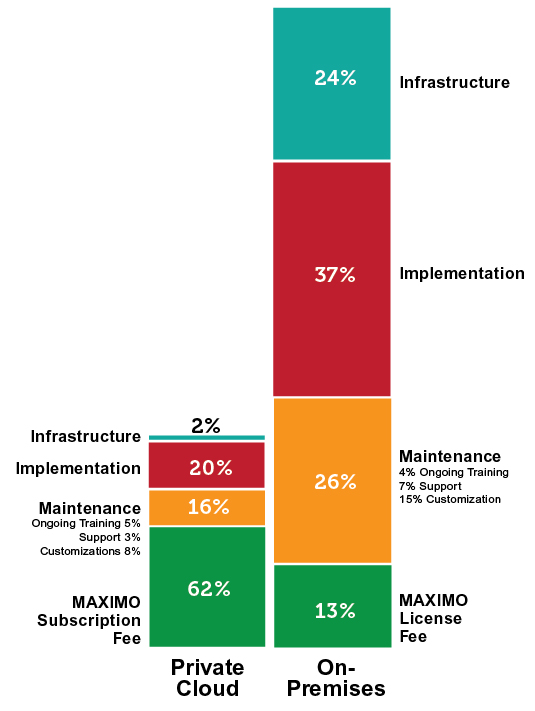In this chart, we compare total and by-category spending of on-premises hosting versus private cloud-based hosting (as delivered by Banetti). With regard to specific costs and relative spend, “mileage may vary.” There are many factors that affect the cost model; but in our experience, these proportions hold up over 4-5 years.
Category Definitions
Infrastructure
- In an on-premises scenario, this cost is assumed to be the proportional share of internal infrastructure costs (calculated by number of users and by size of Maximo installation), IT personnel, networking costs, security costs and all associated costs required to set up and manage the infrastructure. Associated costs include the hardware maintenance, non-Maximo software maintenance, backups and so on.
- For cloud-based deployments, these costs are covered by the subscription fees. There may be certain indirect infrastructure costs such as IT’s maintaining client-side hardware and the local network. These costs, however, are minimal and part of operating the company generally.
Implementation
- In both cases, implementation includes initial discovery, design workshops, data loading, KPI and roles mapping, dashboard setup, and initial reports set up. The deliverables include documents on business requirements, architectural requirements, process documents, project timelines and the management of all of these processes.
- For on-premises deployments, there is significant additional cost in coordinating with internal IT, particularly for design changes, updates/upgrades, user and other administrative management, adding/removing servers, database changes/updates, network, security, Disaster Recovery, testing and any other required component for the deploying.
- For a private cloud, most of the IT-based costs are covered over time as part of the subscription costs.
Maintenance
- Post-implementation training, the addition of features over time, user enablement, and support costs. These comparisons assume that companies have increasing needs over time (number of users, for example).
- For on-premises deployments, we estimate all associated cost-attribution internally to cover (for example) all levels of support. Sometimes 2nd and/or 3rd tier support is spent with IBM or a third party in a costly, annual maintenance contract. But all support related to infrastructure and related software (e.g. database) is covered by internal costs.
- For cloud deployments, except for first tier support, all maintenance is usually included in the cost of the per-user subscription. Numbers of users (i.e. volume) and length of commitment are important in overall cost. Certain tasks may be extra here, such as custom reports or backend implementations.
Fees
- License fees in the on-premises case covers initial Maximo licensing fees. Those costs are generally applied solely to cost of using the software alone.
- Annual subscription fees in the cloud case covers patches, hot fixes, upgrades, support, server infrastructure, disaster recovery, and all affiliated licensing.
Analysis
In our experience, the cost of hosting Maximo in a private cloud is about 1/3 the Total Cost of Ownership (TCO) of hosting Maximo on-premises over 5 years. Principally, this stems from the ongoing, attributable, IT costs associated with hosting a Maximo installation as well as the challenging task of matching license types and numbers to the changing number of users and user-types in a growing enterprise.
Although subscription fees can ultimately exceed license costs, those subscription fees cover many–even most–of the categories that are “extra charges” in an on-premises situation, including support, maintenance, certain training and of course, all IT costs related to maintaining a modern, reliable, secure infrastructure.
Note that customization of the backend can be carried out regardless of the hosting method.
Depending on how companies manage infrastructure costs’ impact on their P&Ls, there are benefits to a cloud-based deployment related to finance: fixed CAPEX expenses can be shifted to a variable OPEX categorization.
Banetti’s perspective is neutral overall. That is, choosing how to deploy Maximo EAM in your organization depends on many factors. We have a firmer opinion on the value of a private cloud-based implementation in situations where a) IT resources are not readily available; b) total cost over time is a critical issue, rather than a nice-to-have; c) time of implementation and support is of the essence.
Finally, although it might not be intuitively obvious, security can most times be managed better in a hosted environment.
We can help you walk through your specific situation mapped to the model we present here.
